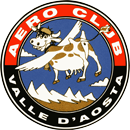Flying Activities
Pilots can take part in flying activities every day, all year round, whether or not they are members of Aero Club Valle d’Aosta.
For pilots who are not members, training sessions are generally organised at various times of the year. Notably, every spring there are wave soaring training sessions usually attended by an average of 70 crews from all over Europe, especially from Germany and the Netherlands.
Flying Environment
Aosta Airport is 545 metres above sea level and is located about 3 km east of the city centre. The city (and with it the airport) are therefore located a third of the way along the section of the Aosta Valley that runs between the towns of Courmayeur and Saint Vincent, about 63 km from the mouth of the valley if we follow the valley itself. This distance from the plain, together with the fact that the valley turns sharply south at Saint Vincent (an angle of around 70°), offers extraordinary conditions for takeoff and gliding in the area around the airport and the entire valley. Often, the weather in the upper valley (Saint Vincent-Courmayeur) is very favourable for flying and totally different from the typical conditions in the stretch along the lower valley (from Saint Vincent to the plain).
Within a minimum of 22 km (the Grand Combin at 4,314 m) and a maximum of 55 km (Monte Rosa at 4,634 m) stand Europe’s highest peaks (Mont Blanc, the Matterhorn), while nearby there are peaks of over 3,500 metres such as Monte Emilius (3,557 m) just 7 km south of the airport.
The passes connecting with the nearby valleys are all very high (all above 2,000 m).
Throughout spring and summer, and often also in autumn, on sunny days (even with light clouds) a considerable valley breeze picks up starting at about 1 pm and goes on until late afternoon. As a result, pilots can soar using the lift generated on the ridges of the town of Arpuilles, 5 km from the airport. With regard to thermal inversions, the altitude that can be reached in this way varies greatly. Pilots can almost always reach 1,000 metres QFE, high enough to move over and pick up powerful thermals on the ridges of Blavy, on the opposite side of the valley.
On days with these conditions, pilots can almost always reach 3,000 metres QNH, often 3,500 metres QNH, and sometimes 4,000 metres QNH.
On days with winds at altitude, even if these are weak, wave phenomena are triggered and spread to the upper layers of the atmosphere. Often, the wind also affects the lower layers all the way down to ground level, allowing tows to 400/600 metres on the ridges of Monte Emilius, located 1 km south of the field.
These days are frequent throughout the whole year, but especially in the spring, when they allow fantastic flying up as high as the stratosphere. The Italian altitude records (single and twin-seat) have been broken several times in the skies above the Aosta Valley. The Aosta Valley and the valleys that run alongside it extend to around 460 kilometres overall, all of which can be explored at a safe altitude with respect to the airport.
The environment is harsh and often challenging for glider pilots, but it is striking with its sheer pinnacles, dark rocks silhouetted against the blue sky, glaciers sparkling in the sun, deep green valleys, white cumulus clouds clinging to mountains, powerful and turbulent rotors, incredibly smooth lenticular clouds, crows, hawks, buzzards, eagles…
A flight in the Aosta Valley is an exciting and unforgettable experience!

 Italiano
Italiano English
English Deutsch
Deutsch Español
Español